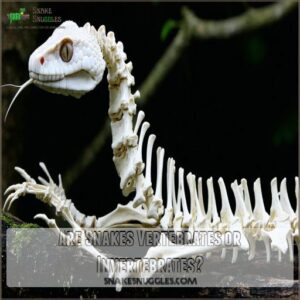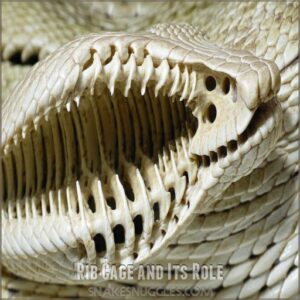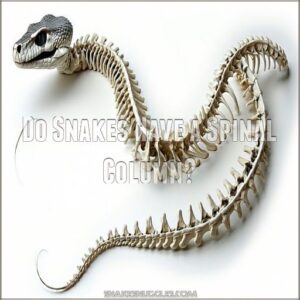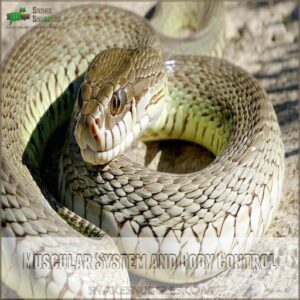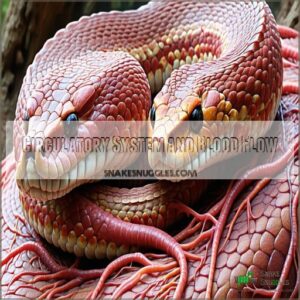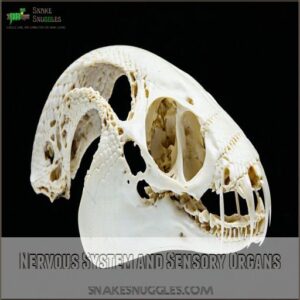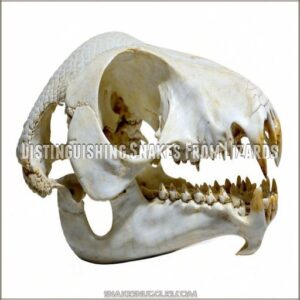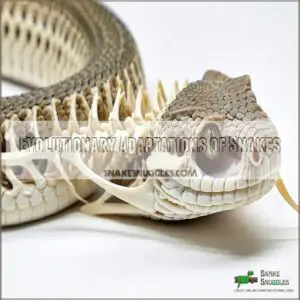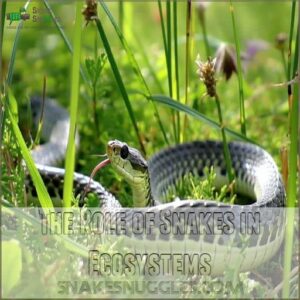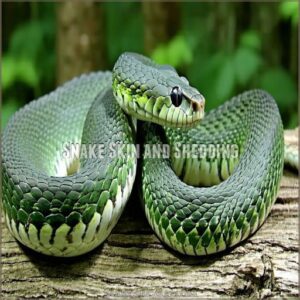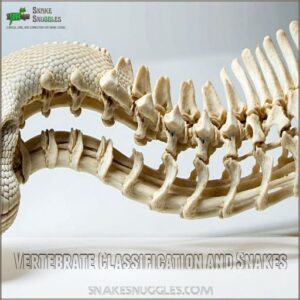This site is supported by our readers. We may earn a commission, at no cost to you, if you purchase through links.
 Yes, snakes are vertebrates, which means they have a backbone.
Yes, snakes are vertebrates, which means they have a backbone.
You might think of vertebrates as a club with a membership requirement: possessing an internal skeleton and spinal column.
Snakes proudly fit the bill with their elongated bodies supported by a series of vertebrae, allowing them to slither with grace and precision.
Their flexible spine, composed of 100-400 vertebrae connected by flexible joints and muscles, contributes to their remarkable ability to move effortlessly, whether they’re gliding through grass or coiling around branches.
So, next time you spot one of these legless wonders, remember, you’re looking at a fully-certified member of the vertebrate family.
Curious about their mysterious anatomy? Read on!
Table Of Contents
- Key Takeaways
- Defining Vertebrates and Invertebrates
- Are Snakes Vertebrates or Invertebrates?
- What is a Snake’s Skeletal System?
- Do Snakes Have a Spinal Column?
- Snake Anatomy and Movement
- Distinguishing Snakes From Lizards
- Evolutionary Adaptations of Snakes
- The Role of Snakes in Ecosystems
- Snake Skin and Shedding
- Vertebrate Classification and Snakes
- Frequently Asked Questions (FAQs)
- Are snakes vertebrates or invertebrates?
- Do snakes have vertebrae?
- Do snakes have a backbone?
- Do snakes have a skeleton?
- How are snakes different from other vertebrates?
- Are snakes vertebrates or lizards?
- How do snakes move?
- Do snakes have ears?
- How fast do snakes grow?
- What is molting in snakes?
- What physical trait sets snakes apart from other reptiles?
- Do snakes have a backbone?
- Why are snakes vertebrates and earthworms are not?
- How many vertebrae are in a snake?
- How many bones are there in a snake?
- How do snakes detect their environment?
- What is the function of snake scales?
- How do snakes reproduce?
- Can snakes move backwards?
- What are common snake predators?
- Conclusion
Key Takeaways
- Snakes are vertebrates, meaning they have a backbone composed of numerous vertebrae that support their unique slithering motion.
- Their skeletal system, including a flexible spine and ribs, allows for remarkable movement and efficient prey capture.
- Unlike invertebrates, snakes possess an internal skeleton, distinguishing them clearly within the vertebrate family.
- As key predators, snakes play a crucial role in maintaining ecological balance by controlling prey populations.
Defining Vertebrates and Invertebrates
When you’re trying to classify animals, knowing the difference between vertebrates and invertebrates is essential, as it can clear up common misconceptions.
Vertebrates have a backbone that supports their body structure, while invertebrates lack this feature, relying on other body parts for support and movement.
Characteristics of Vertebrates
Sporting a backbone, vertebrates boast an internal skeleton that supports the whole operation, much like a well-funded infrastructure project.
This structure includes a spinal column protecting their nervous system like a personal bodyguard.
Much like how a snake’s habitat requires proper humidity control to prevent respiratory problems in snakes snake respiratory issues.
Toss in a circulatory system and a skull to house a central nervous system, and you’ve got a well-oiled machine regulating body temperature and movement.
Characteristics of Invertebrates
Now that we’ve explored vertebrates, let’s look at their opposites: invertebrates. These animals don’t have a backbone, which is a pretty big difference! Think of the amazing variety:
- Insects with their exoskeletons and jointed legs.
- Spiders spinning intricate webs.
- Worms slithering through the soil.
- Squid with their incredible camouflage.
- Starfish, with their unique radial symmetry.
Invertebrates showcase incredible diversity, adapting to almost every habitat imaginable.
They lack an internal skeleton but often have tough outer coverings.
Are Snakes Vertebrates or Invertebrates?
Imagine you’re out for a hike and spot a sinuous creature slithering by. Is it a vertebrate or an invertebrate? You might be surprised to learn that snakes, despite their lack of limbs, are indeed vertebrates.
They belong to the same group as mammals and birds, boasting a backbone and an internal skeleton. This classification roots back to snake evolution from ancient lizards, giving them unique adaptations.
Unlike invertebrates, such as insects, snakes have a flexible spine that supports their slippery locomotion and intricate anatomy. Their vertebrae, ribs, and complex nervous system highlight their evolutionary journey within the vertebrate family, distinguishing them clearly from their exoskeleton-bearing, spineless counterparts.
What is a Snake’s Skeletal System?
You might think of a snake’s skeleton as a delicate framework designed for flexibility, but it’s actually a robust system made up of hundreds of vertebrae and ribs that offer support and protection.
This unique structure allows snakes to move with remarkable agility, showcasing the vertebrate traits they share with other animals, despite their legless appearance.
The Backbone and Its Functions
You might be surprised to learn that a snake’s backbone is like a well-oiled machine, allowing flexibility and mobility.
This intricate vertebral structure supports muscle attachment and protects the spinal cord, all without a single leg to spare!
The spine’s development over time helps these creatures glide and twist, turning them into nature’s stealthy and adaptive movers.
Rib Cage and Its Role
The snake’s unique skull structure, which resembles a complex jigsaw puzzle, is a crucial part of its snake skeletal structure flexibility. The snake’s rib cage plays a key role in its skeletal structure.
It supports the body in several ways:
- Breathing mechanics: The ribs expand for lung capacity, aiding respiration.
- Prey swallowing: The flexible ribs adjust to engulf large meals.
- Snakes also have unique snake vertebrae support, which can be found in various forms such as snake vertebrae products.
- Body flexibility: This structure allows snakes to navigate tight spaces effortlessly.
By understanding these, you gain insights into their unique adaptation.
Vertebrae and Joints
Just as their rib cages assist in protection, snakes have a fascinating vertebral column comprising hundreds of vertebrae connected by flexible joints.
This intricate network allows them remarkable joint flexibility, enabling their slithering prowess.
Imagine a complex, living chain that facilitates fluid snake movement, showcasing vertebral evolution at its finest.
This backbone anatomy supports their dynamic skeletal system and efficient locomotion.
Do Snakes Have a Spinal Column?
When you think of snakes, you might picture their slithering movements, but did you know they actually have a well-developed spinal column?
This backbone provides essential support and protection to their internal organs, but it also plays a key role in their respiration and allows for the remarkable agility and flexibility that enables their unique mode of travel.
Support and Protection
Snakes, unlike insects with their external exoskeletons, possess a robust internal skeleton.
Their backbone, a series of vertebrae, provides vital support for their long, flexible bodies.
This bone structure protects the spinal cord, the central nervous system’s command center.
The rib cage, although lacking a sternum, adds further protection and assists in movement.
Strong muscles attached to the vertebrae and ribs enable the snake’s remarkable slithering.
This intricate system guarantees both mobility and protection against predators and environmental hazards.
Respiration and Oxygen Intake
Breathing might seem effortless for snakes, but their respiratory system is fascinatingly unique.
With a backbone providing structure, snake lungs efficiently handle gas exchange.
Imagine a stretched accordion, where each vertebra helps push oxygen through the body.
Most snakes have one working lung, ensuring oxygen consumption stays at its peak.
It’s this clever design that keeps them stealthily slithering along.
Mobility and Movement
Imagine gliding silently through your garden without legs—that’s how snakes achieve their mesmerizing slithering.
Muscular contractions propel them forward, utilizing the spinal column for seamless locomotion.
Their skeletal structure, with flexible vertebrae and ribs, lets them twist and turn with grace.
This body flexibility isn’t just for show—it’s a masterclass in movement and mobility honed by evolution.
Snake Anatomy and Movement
When you explore snake anatomy, you’ll find that their muscular system, circulatory system, and nervous system work intricately together to create their characteristic slithering motion and control bodily functions.
Their unique body structure, with flexible joints and sensory organs, facilitates movement but also a finely tuned coordination, enabling snakes to navigate their environment efficiently.
Muscular System and Body Control
- You’ve marveled at the snake’s slithering mechanics and might wonder how they glide so smoothly without limbs. The secret: muscle strength and body flexibility working in harmony.
- Muscular Coordination: Snakes use over 10,000 muscles for precise movements.
- Body Movement: Their muscular system enables seamless navigation across varied terrains, showcasing the elegance unique to vertebrates like them.
Circulatory System and Blood Flow
Now that you’ve explored a snake’s muscular system, let’s look at their circulatory system.
Picture a snake’s heart pumping blood through a network of blood vessels.
This reptilian heart does serious work managing blood pressure and oxygen transport across its elongated body.
Among vertebrates, snakes show unique circulatory adaptations, ensuring effective blood flow and sustaining their fascinating movement and lifestyle.
When encountering snakes in the wild, it’s important to exercise snake safety precautions to avoid potential dangers.
Nervous System and Sensory Organs
Ever wonder how snakes find their way around without hearing or seeing like we do?
Their nervous system, packed in a backbone, turns them into sensory ninjas.
Snake vision isn’t great, but their olfaction and chemoreception — think of them as sniffing with their tongues — are excellent.
With heat sensing and vibrations picking up the slack, snakes are highly attuned hunters.
Distinguishing Snakes From Lizards
You’ll find that while snakes and lizards share common ancestry as squamates, key differences exist, such as the absence of limbs in snakes and variations in skull structure impacting prey capture.
These distinctions, along with other anatomical features, help us easily differentiate these fascinating reptile relatives.
Similarities Between Snakes and Lizards
Though snakes and lizards might seem worlds apart, these relatives within the order Squamata share a few traits.
Both sport scales for protection and moisture control.
They belong to the vertebrate club, boasting backbones with countless vertebrae.
However, unlike lizards, snakes have evolved without limbs, trading their legs for a streamlined, slithering journey through nature.
Differences Between Snakes and Lizards
Peeling back layers of evolution, you’ll find distinct differences between snakes and lizards:
- Limb Evolution: Snakes lost limbs for sleek, slithery movement.
- Body Shape: Lizards flaunt a wider torso and visible limbs.
- Sensory Organs: Snakes, lacking eyelids, sport transparent scales over their eyes.
- Habitat Adaptation: Snakes, optimized for burrowing, can thrive in tighter spaces.
Evolutionary Adaptations of Snakes
You might marvel at how snakes, with their evolutionary adaptations, have mastered the art of slithering through landscapes that their limbed relatives find challenging.
Through limblessness, jaw flexibility, and venom delivery, snakes have evolved into highly efficient predators and survivors.
Limblessness and Its Advantages
Limblessness gives snakes a slithering grace, letting them slip through tight spaces with remarkable ease.
Imagine sneaking into a movie without a ticket—unnoticed and smooth.
Notably, snakes’ ancestors had legs, as seen in fossil leg records, but over time, they evolved to lose them, gaining an advantage in mobility and efficiency.
Here’s how these adaptations shake out:
| Adaptation | Advantage | Example |
|---|---|---|
| Slithering | Mobility | Fast escape |
| Burrowing | Shelter | Nest creation |
| Swiftness | Hunting | Swift prey capture |
| Camouflage | Stealth | Predator evasion |
| Evolution | Adaptation | Survival boost |
Embrace the mystery!
Jaw Flexibility and Prey Capture
Snakes’ jaw flexibility is your ticket to understanding their unique feeding strategy.
They can dislocate their jaws, allowing them to tackle prey much larger than their head, a feature showcased in products related to snake jaw movement mechanisms.
This jaw dislocation, coupled with swallowing mechanics, lets them ingest a variety of prey sizes.
Unlike constrictors, some opt for venom injection, but either way, their vertebrae and jaw work seamlessly for efficient prey capture.
Venom Delivery and Defensive Mechanisms
Just as a snake’s jaw flexes to capture prey, its venom delivery is a sophisticated art.
With venomous snakes, fangs are precision tools:
- They inject venom types specifically adapted for hunting or defense.
- Defensive bites often involve controlled venom amounts.
- Venom control helps reduce unnecessary energy use.
- Antivenom development depends on understanding these intricate venom systems.
The Role of Snakes in Ecosystems
You’ll discover that snakes, despite their often-feared reputation, play important roles in maintaining ecological balance.
They’re key predators, controlling populations of rodents and other small animals, consequently impacting food webs and the overall health of their habitats.
Ecological Roles and Importance
Snakes might’ve left behind their limbs, but they hold a key spot in the ecosystem as master regulators.
Acting like an unseen thumb on nature’s scale, they control pest populations and support biodiversity, often relying on products from snake conservations stores like snake ecosystem role products.
Think of them as guardians, offering ecosystem services by maintaining balance.
Their role as a keystone species is essential for wildlife conservation, despite fears of venomous snakes.
Impact on Food Chains and Webs
Ever wondered how snakes maintain ecosystem balance?
As predators, they play a key role in population control within food chains.
By regulating prey species, they help sustain biodiversity and contribute to stable trophic levels.
These vertebrates influence ecosystems by keeping prey populations in check, ensuring a dynamic equilibrium that supports overall ecological health.
In specific ecosystems like wetlands, they possess remarkable aquatic adaptations, such as streamlined aquatic bodies.
In short, snakes are essential ecosystem managers.
Snake Skin and Shedding
When you think of a snake’s skin, imagine a living, scaly armor made of keratin that shields it from the environment while conserving moisture.
Ecdysis is the process by which snakes shed their entire skin.
This regular shedding allows snakes to accommodate their expanding bodies and replace worn exterior layers.
Scales and Their Functions
While snakes play important roles in ecosystems, their unique scales are worth exploring.
These fascinating scales, composed of keratin, protect but also grant mobility, sliding like a well-oiled machine.
Scale types and patterns vary, aiding camouflage and enabling evolutionary wonders, from brilliant coloration to stealthy blending.
Their resilience shows nature’s craftsmanship, an intricate tapestry covering these enigmatic reptiles—vertebrates with flair.
Ecdysis and Skin Renewal
Imagine your snake friend casually slipping out of its skin suit—a process called ecdysis.
This shedding rejuvenates its scales, promoting skin health and supporting growth cycles.
It’s a natural process that typically occurs 2-4 times per year, depending on the snake’s age, diet, and environmental conditions, as you can learn more about in the snake skin shedding process explained.
This natural renewal keeps these reptiles agile and healthy, ensuring they thrive as extraordinary vertebrates.
Vertebrate Classification and Snakes
When you think about classifying vertebrates, snakes might slither their way to the top of your mind.
These intriguing reptiles, with their elongated bodies and flexible backbones, fit right into the vertebrate category due to their internal skeletons and complex anatomy.
Taxonomy and Phylogeny
Snakes belong to the order Serpentes within the class Reptilia.
Understanding their classification requires exploring reptile phylogeny, a branching diagram illustrating evolutionary relationships.
Scientists use these phylogenetic trees to trace snake evolution, mapping their unique characteristics and ancestry within the broader vertebrate family.
This intricate system of classification helps researchers understand snake diversity and evolution.
The study of snake classification and their evolutionary history is ongoing.
Relationship Between Snakes and Other Vertebrates
A snake’s place among vertebrates is like a unique dance on a much larger evolutionary stage.
Sharing ancestors with lizards, snakes illustrate vertebrate evolution beautifully.
- Backbone and Spinal Column: Essential for slithering movement.
- Reptilian Adaptations: Limbs lost for improved stealth.
- Vertebrae Variations: Adapted for flexibility.
- Evolutionary History: Traces of ancient pathways etched in their anatomy.
Frequently Asked Questions (FAQs)
Are snakes vertebrates or invertebrates?
Think about a knight’s armor and you’ll understand that snakes are vertebrates, boasting a flexible backbone that supports movement.
Unlike invertebrates like worms, snakes possess an internal skeleton, making them agile and effective hunters.
Do snakes have vertebrae?
You might be surprised to learn that snakes have vertebrae, making them vertebrates.
Their long spine is composed of about 200 to 400 vertebrae, allowing them to twist and turn with incredible flexibility and grace.
Do snakes have a backbone?
Yes, they do! Snakes are vertebrates, meaning they possess a backbone, a key part of their internal skeleton. This backbone supports their body, allowing them to slither and move efficiently.
Do snakes have a skeleton?
Snakes have a skeleton that’s as flexible as a gymnast, composed of hundreds of vertebrae running the length of their body.
This skeletal structure gives them the ability to slither, coil, and strike with precision.
How are snakes different from other vertebrates?
Unlike other vertebrates, snakes lack limbs and exhibit a highly elongated body structure.
Snakes possess a bony skeleton, not a cartilage-based one, as explained in snake skeletal anatomy. Snakes have a unique skeletal anatomy, which includes flexible vertebrae and ribs.
This unique anatomy allows them to slither efficiently, fitting through tight spaces with ease.
Are snakes vertebrates or lizards?
You’re wondering if they’re vertebrates or lizards, which sounds confusing.
Snakes are actually a type of reptile in the order Squamata, just like lizards, but they’re distinct vertebrates characterized by their limbless, elongated bodies.
How do snakes move?
Imagine watching a snake gracefully glide across a path.
They do this by flexing their spine and using muscles to push their scales against surfaces.
This creates a ripple effect that propels them forward smoothly and efficiently.
Do snakes have ears?
Snakes don’t have external ears like you do.
Instead, they detect vibrations through their jawbones, which are connected to their inner ear.
This setup helps them "hear" prey or danger approaching through subtle ground vibrations.
How fast do snakes grow?
Snakes’ growth rates depend on species, diet, and environment.
Typically, younger snakes grow rapidly, sometimes doubling in size during the first year.
Their growth slows with age, but they continue to shed skin and grow throughout their lives.
What is molting in snakes?
You’ll see snakes shed their skin; it’s called ecdysis.
This process, essential for growth and getting rid of parasites, involves the old skin peeling off in one piece.
Pretty cool, huh?
What physical trait sets snakes apart from other reptiles?
In contrast to other reptiles, snakes’ defining characteristic is their elongated bodies with no limbs, moving through slithering.
This flexible form allows them to navigate effortlessly through diverse environments, blending stealthy grace with evolutionary advantage.
Do snakes have a backbone?
Yes, snakes have a backbone, which makes them vertebrates.
Their spine is highly flexible, with hundreds of vertebrae, allowing them to move smoothly and efficiently without legs.
This anatomical feature supports their slithering motion.
Why are snakes vertebrates and earthworms are not?
Snakes have a backbone, making them vertebrates, while earthworms don’t.
Unlike snakes, earthworms lack a spinal column, which contributes to their classification as invertebrates.
Earthworms rely on a hydrostatic skeleton for movement and support.
How many vertebrae are in a snake?
You’re curious about snake anatomy, right?
Well, these limbless reptiles typically boast between 200 to 400 vertebrae along their extended spines.
This extensive flexibility facilitates their signature slithering movement, making them fascinating creatures to study.
How many bones are there in a snake?
A snake has between 200 to 400 bones, depending on its species.
This includes numerous vertebrae connected by flexible joints, allowing the snake to slither and twist gracefully, making it one of nature’s most agile reptiles.
How do snakes detect their environment?
Imagine slithering through a dark forest, relying on your tongue to detect the world around you.
Snakes do just that, using their forked tongues to pick up chemical cues and their Jacobson’s organ to interpret them.
What is the function of snake scales?
Snake scales are made of keratin, offering protection from injury and dehydration.
They also aid in movement and camouflage, helping snakes thrive in diverse environments.
Shedding their skin (ecdysis) allows for growth and repair.
How do snakes reproduce?
Snakes reproduce through internal fertilization.
Males use specialized organs called hemipenes to transfer sperm to females.
Females can store sperm for extended periods, sometimes delaying fertilization.
Egg-laying and live birth vary by species, adding reproductive diversity.
Can snakes move backwards?
It’s not a common sight, but if a snake feels the need, it can move backward.
They navigate by contracting their muscles, and while it’s not their usual direction, a backward shuffle is possible.
What are common snake predators?
Common snake predators include birds of prey like eagles and hawks, larger mammals such as foxes and raccoons, and even other snakes.
Predators rely on their keen senses and speed to catch snakes effectively.
Conclusion
Like an intricate puzzle, understanding snakes reveals the complexity of the vertebrate world.
Snakes are indeed vertebrates, equipped with a flexible spinal column that supports their remarkable movements and diverse adaptations.
From their elongated skeleton, which includes myriad vertebrae, to their muscular and sensory systems, these creatures demonstrate the fascinating interplay of anatomy and function.
By grasping this concept, you gain insight into snakes’ roles in ecosystems and their evolutionary marvels, reinforcing their place in nature’s grand scheme.


